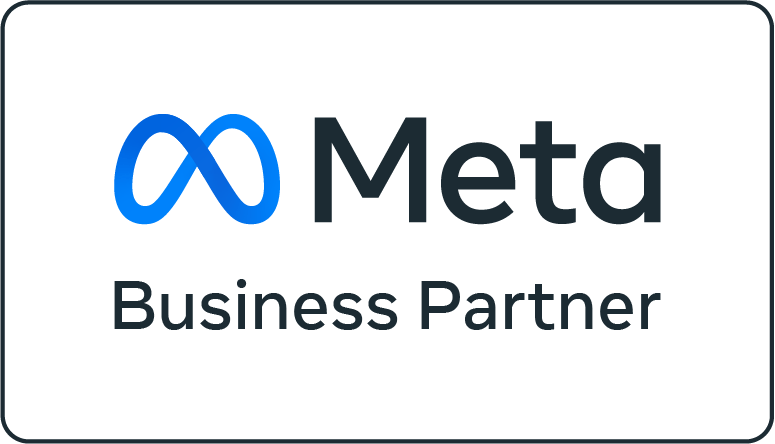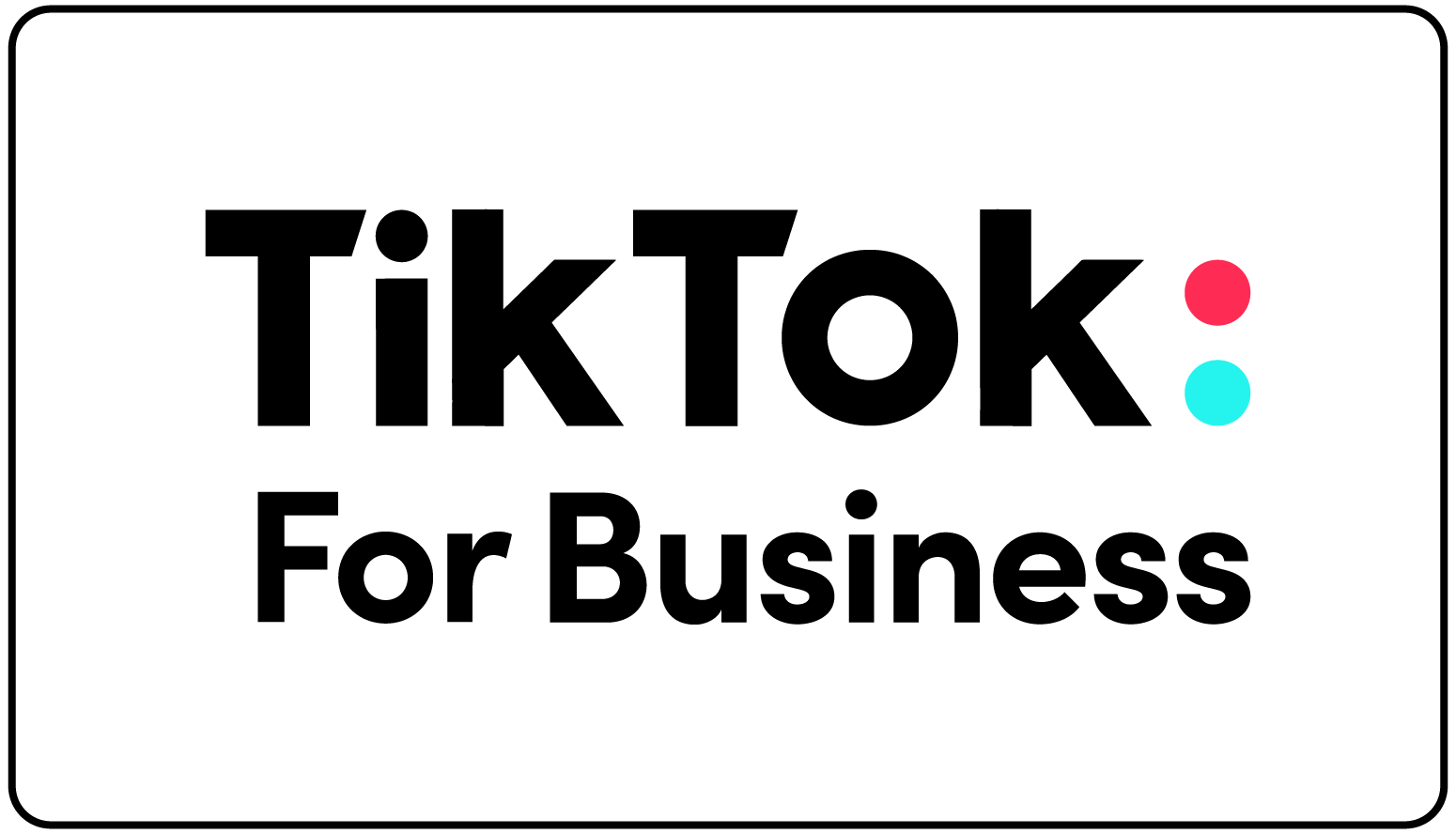What is Creative Strategy?
In the context of paid social, a creative strategy is more than just a one-time plan; it’s an ongoing, iterative process that informs the production and deployment of your visual and textual assets. It involves not only creating eye-catching images or videos, but aligning these elements cohesively with your brand’s core values, target audience, and campaign objectives.
Open and continual communication among team members is crucial for the strategy’s success, ensuring everyone stays aligned and can quickly adapt to new insights or challenges.
Exercises in idea generation and message testing are often incorporated into the strategy, enabling you to continually refine your approach based on real-world performance and feedback. The use of formal creative briefs serves as the guiding document to keep everyone on track, making sure that each ad not only looks good but also resonates with viewers and inspires meaningful actions like purchases, sign-ups, or content sharing.
How Has Paid Social Creative Changed Over the Years?
Paid social creative has evolved significantly, especially on platforms like Facebook, Instagram, and TikTok. In the early days, a paid social ad was often just simple text and images. Today, the creative landscape has expanded to include rich formats like carousel ads, interactive elements, and video, including vertical video formats popularized by TikTok and Instagram Stories.
The rise of machine learning and AI algorithms on these platforms has made ongoing creative optimization a necessity. Authenticity and storytelling are more crucial than ever, with users gravitating towards content that feels native to the platform. This has led to the growing importance of user-generated content (UGC) and influencer partnerships in creative strategies. Overall, the creative landscape is increasingly dynamic, requiring agility and data-driven decision-making from advertisers.
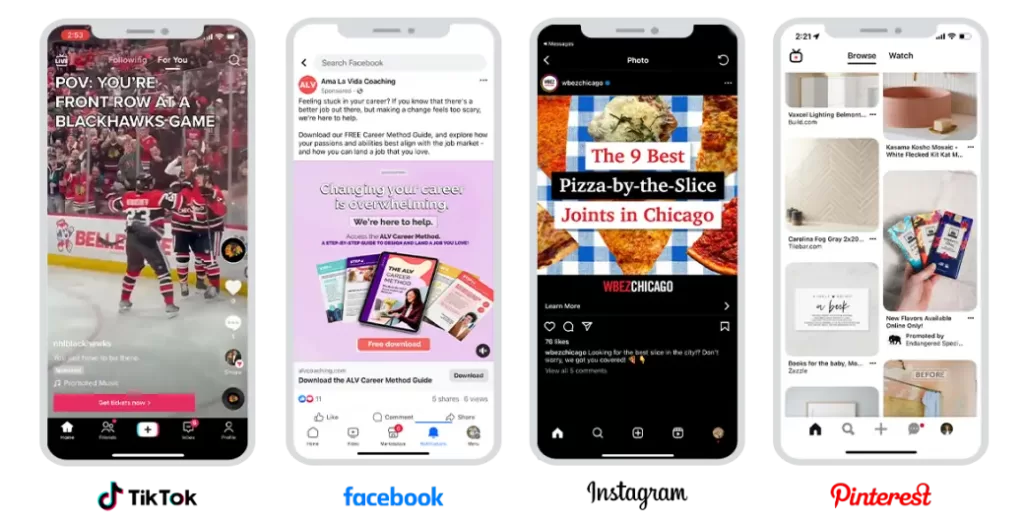
Anatomy of a Paid Social Ad
Newsfeed
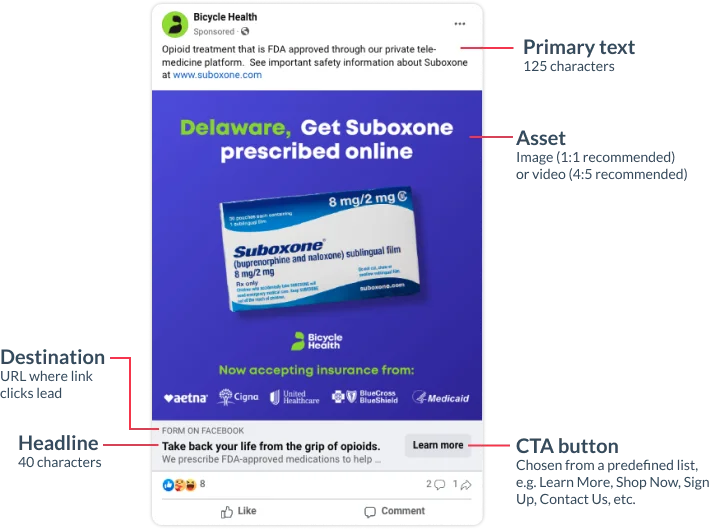
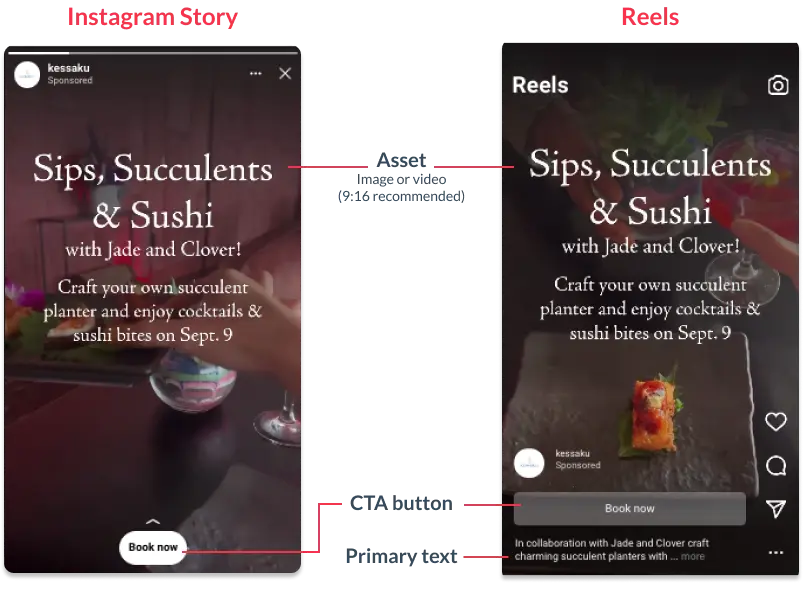
Asset Safe Zone
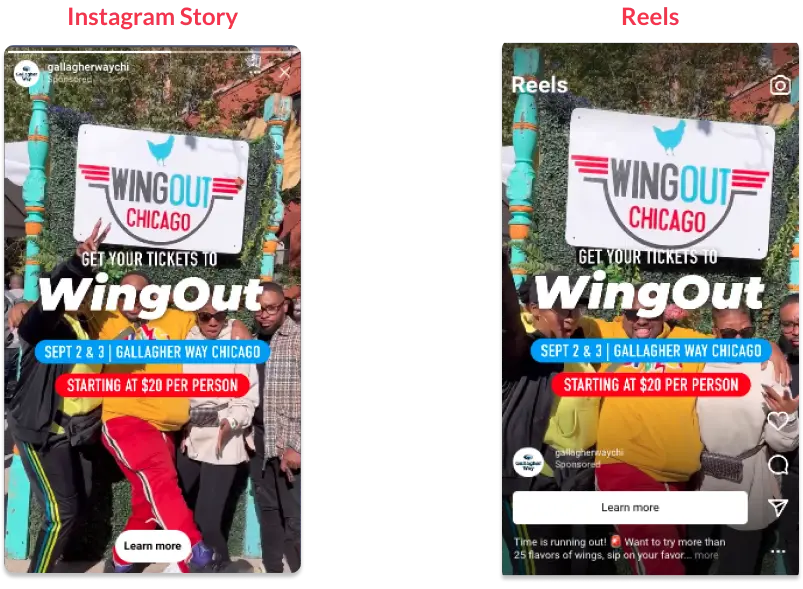
What are Current Creative Best Practices for Paid Social?
- Attention-Grabbing Elements: Given the short attention span of social media users, it’s crucial to make your ad stand out within the first few seconds. Using dynamic visuals, compelling copy, and engaging formats like video can accomplish this.
- Consistency Across Platforms: While each platform has its own nuances, maintaining brand consistency across paid media and across all platforms is essential. This helps in solidifying brand recognition and trust.
- Data-Driven Decisions: Use analytics tools to understand what’s working and what isn’t. MotionApp.com is an excellent resource that bridges the gap between creatives and media buyers. By improving data visibility, it enables real-time adjustments to creative elements, thereby optimizing campaign performance.
- Mobile Optimization: With most social media engagement occurring on mobile devices, ensure your creative is optimized for a mobile-first experience. This includes vertical video formats popularized by platforms like TikTok and Instagram Stories.
- A/B Testing: Run multiple versions of your ad to understand what elements are driving engagement and conversions. This allows for a more nuanced understanding of what your audience responds to.
- Authenticity and Relatability: Users are savvy and can spot overly promotional or fake content from a mile away. Aim for authenticity, storytelling, and a focus on benefits over features.
- Clear Calls-to-Action (CTAs): Guide users on the next steps they should take. Whether it’s ‘Learn More,’ ‘Shop Now,’ or ‘Sign Up,’ a clear and compelling CTA is essential for driving desired actions.
- Seamless Workflow: Tools like MotionApp.com also enhance workflow efficiency, making it easier for creative teams to collaborate with media buyers. Efficient workflows mean quicker iterations and more agile campaign adjustments.
By adopting these best practices, you can significantly improve the effectiveness of your creative strategy in paid social campaigns.
How is Paid Social Creative Different by Each Platform?
As outlined in our comprehensive guide to paid social media advertising, each social ad platform differs in important ways. By adapting these best practices, you can significantly improve the effectiveness of your creative strategy in paid social campaigns.
Facebook is a versatile platform that caters to a broad audience. It’s great for long-form content and storytelling through carousel ads or Instant Experience. Video is also highly effective, but it’s crucial to capture attention within the first few seconds.
Facebook allows a variety of ad formats, including dynamic product ads tailored to user behavior, making it ideal for re-targeting.

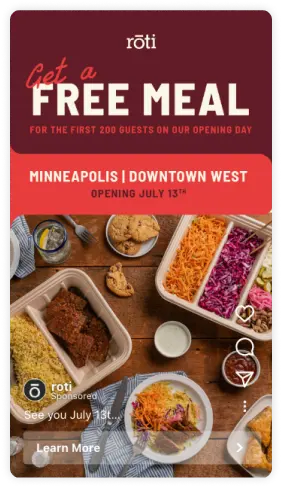
Instagram is a visual-first platform, perfect for showcasing your brand’s aesthetics. High-quality images and short, engaging videos work well here.
With features like Stories, Reels, and IGTV, Instagram provides multiple avenues for creative expression. Instagram is highly effective for lifestyle brands, fashion, food, and any other visual-centric industries.
Google & YouTube
While Google is not a traditional social media platform, its Display Network allows advertisers to place visual ads across various websites. Google focuses more on intent-based advertising, so the creative generally needs to be straightforward and to the point.
YouTube offers a platform for longer-form video content, while YouTube Shorts are designed for quick, engaging videos. Both aim for immediate conversion and usually include a clear call to action.

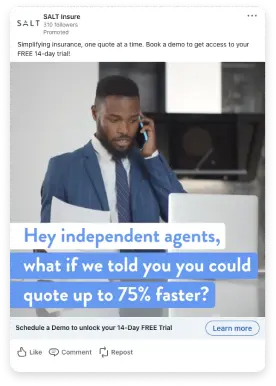
LinkedIn is the go-to platform for B2B marketing. Creative here tends to be more professional and informational. Thought leadership content, such as industry reports or webinars, perform well on this platform.
LinkedIn is excellent for targeting by job title, industry, and other professional criteria, so your creative can be very tailored to your audience.
Twitter (Now X)
Twitter is a fast-paced platform where concise, timely, and sometimes witty content shines. Visual elements like images and videos can make your ads stand out, but the messaging is often just as crucial.
Twitter is excellent for real-time events and news-related topics, and its user base tends to be more tech-savvy.
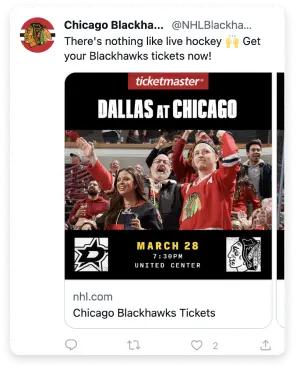
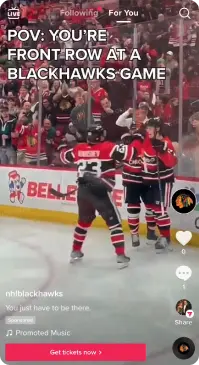
TikTok
TikTok is the epitome of short-form video content. Creatives should aim for highly engaging, entertaining, or informative videos that fit seamlessly into the user’s For You Page.
Authenticity is vital; overly polished or traditional ads usually fall flat. Vertical video is the norm, and user-generated content often performs exceptionally well.
Each platform has its unique strengths and audience, requiring a distinct approach to creative strategy to maximize your campaigns’ effectiveness.
What Are the Best Graphic Design Tools for Social Media Advertising?
Canva

Canva is a user-friendly tool that’s perfect for creating Facebook ads or any other type of social media content. It offers a wide range of templates tailored for various social media platforms, making it a great choice for businesses that aim to reach a broad audience but may not have a specialized design team.
The Pro version offers even more features, including the ability to customize your brand’s color palette, fonts, and logos for a cohesive campaign. Canva has also started integrating AI elements to suggest design layouts and color schemes.
Adobe Creative Suite

For those who require more advanced capabilities in their social ads, the Adobe Creative Suite is a comprehensive set of tools that can meet these needs.
Photoshop is great for intricate image editing, while Illustrator is ideal for vector designs. Adobe Premiere Pro and After Effects are the go-to choices for video-focused campaigns.
Adobe’s Sensei AI assists in automating mundane tasks and offering intelligent design suggestions.
Figma

Figma is a cloud-based tool that allows for real-time collaboration, making it highly effective for social media advertising teams. Multiple team members can work on a single campaign simultaneously, ensuring seamless collaboration and a unified audience approach.
Figma has also started to integrate AI functionalities for enhanced user experience and design features.
Snappa

Much like Canva, Snappa is a simplified design tool that provides pre-made templates perfect for quick and straightforward social media ads.
It’s a suitable tool for small businesses or solo entrepreneurs who need to create engaging content for a targeted audience quickly.
Crello

Crello offers animated design templates, adding an interactive layer to your social media campaigns. It’s an excellent alternative for those who want to experiment with animated or video content without a steep learning curve.
AI features in Crello assist in automating some design tasks and providing suggestions.
PicMonkey

Much like Canva, Snappa is a simplified design tool that provides pre-made templates perfect for quick and straightforward social media ads.
It’s a suitable tool for small businesses or solo entrepreneurs who need to create engaging content for a targeted audience quickly.
GIMP

The GNU Image Manipulation Program (GIMP) is a free, advanced alternative to Photoshop. It offers a wide range of editing features perfect for a more intricate social media campaign.
Though it has a steeper learning curve, it’s a cost-effective choice for those who need a versatile tool.
CapCut

CapCut has emerged as a powerhouse in paid social video design, offering a user-friendly interface that even beginners can navigate with ease.
Its rich array of creative elements, coupled with cost-effectiveness, make it a vital tool for crafting visually captivating videos, especially for small businesses and startups on a budget.
Selecting the right design tool depends on your specific needs, the expertise level of your team, and the goals of your social media advertising campaign. These tools cover a spectrum from beginner-friendly to professional-grade, all increasingly incorporating AI elements to automate tasks, offer design suggestions, and improve workflows, giving you various options to suit your campaign’s requirements.
What Are Examples of Exercises to Generate Ideas for Paid Social Creative?
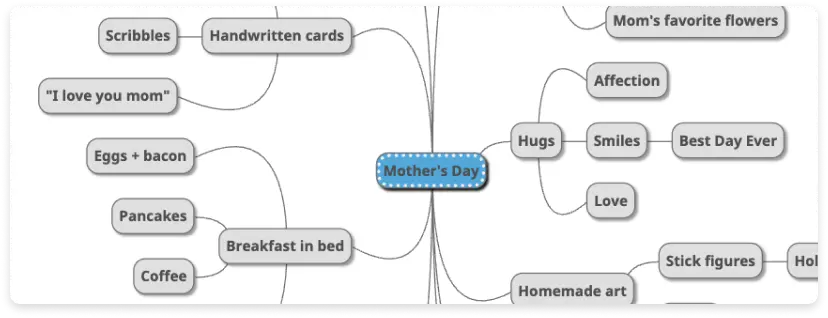
- Brainstorming Sessions with Mind Mapping: One of the most straightforward methods to generate ideas for paid social media marketing is to hold brainstorming sessions with your team and clients, utilizing techniques like mind mapping to visually organize ideas. This can be particularly effective when the client is involved, as they bring a unique perspective on what they want to achieve with the campaign. This can also work to generate ideas for organic social media, Instagram ads, and the like.
- Audience Persona Exercise with AI Integration: Understanding your target audience is crucial for creating a Facebook ad that resonates. Create detailed audience personas, then use AI tools to input this demographic data into a system, which can offer commonalities or feedback on your audience. You can also input your own personas into ChatGPT and ask for ad concept ideas tailored to these personas.
- SWOT Analysis: Conducting a SWOT (Strengths, Weaknesses, Opportunities, Threats) analysis can help you understand the landscape in which your social advertising campaign will operate. This can illuminate unique angles for your creatives to target.
- Reverse Thinking: Sometimes it’s useful to approach the problem from the end goal and work backward. Identify what the desired outcome for the target audience is, such as signing up for a newsletter or making a purchase, and then consider what content will lead the audience to that end goal.
- Thinking in Extremes: A more unconventional but highly effective exercise is to think in extremes. For instance, conceive what you’d do with zero budget and compare it with what you could do with an unlimited budget. These contrasting scenarios often yield some of the most innovative ideas for your campaign.
- Competitive Analysis: Analyzing what competitors are doing can offer insights into what works and what doesn’t in your industry. While you should never copy their ideas, understanding their strategies can be eye-opening and inspire new directions for your creatives.
- Storyboarding: This is particularly useful for video content. Storyboarding allows you to visualize the narrative of your Facebook ad or other social media campaigns, ensuring the message is coherent and engaging from start to finish.
These exercises aim to ignite creativity, align the team with the client’s objectives, and produce effective social advertising content tailored to your target audience.
How Do We Define a Concept vs. an Ad vs. an Asset?
In the realm of paid social advertising, it’s crucial to differentiate between a concept, an ad, and an asset. These terms often get used interchangeably, but they serve unique functions in the creative process.
Concept: A concept is the foundational idea that underpins your campaign. It typically combines a product or service you’re offering with a target audience and an angle or “hook.” The concept serves as the guiding light for the campaign, informing the messaging, visuals, and overall strategy.
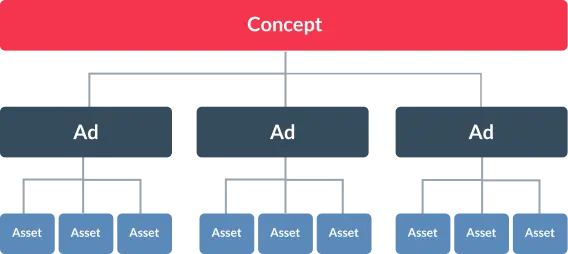
Ad: An ad is a tangible representation of the concept, translated into a format suitable for social media platforms. It involves decisions around format, such as whether it should be a video, a still image, or a carousel. Graphic design elements also play a role here. One concept may manifest as multiple ads, each with its own metrics and tailored to different objectives or audience preferences.
Asset: An asset is the actual file—be it a JPEG, MP4, or any other format—that gets uploaded to the ad platform. Assets are the building blocks that come together to make an ad, which in turn embodies the concept. These are the nitty-gritty components that media buyers upload and track within the ad platform.
Understanding these distinctions helps streamline communication within your creative team and ensures that everyone is aligned on what is being developed, critiqued, or optimized at any given time.
How Do You Make a Creative Brief?
Creating a well-defined creative brief is a crucial step in the development of any successful social advertising campaign, whether it’s a Facebook ad, Tiktok campaign, or content across different platforms. A creative brief serves as the blueprint that aligns the team, the client, and all other stakeholders on the objectives, audience, messaging, and metrics for a campaign. Here’s how to create one:
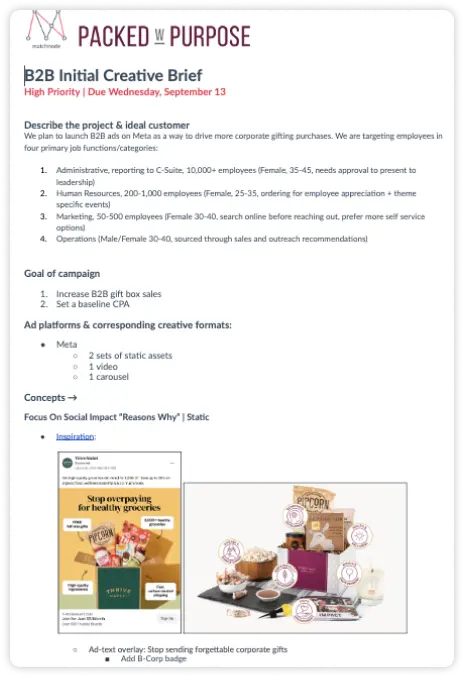
Objective and Goals: Clearly outline what the campaign aims to achieve. Are you looking to increase brand awareness, drive traffic, or perhaps increase sales? Knowing your objectives upfront ensures everyone is working towards the same goal.
Target Audience: Describe the ideal customer profile based on your audience personas. This should include demographic details, psychographics, and any relevant behavioral data. The more specific you can get, the better.
Key Messages: Identify the core messages you want to convey to your target audience. This could be a value proposition, a product feature, or a call to action. Make sure the messaging aligns with the objectives and resonates with your audience.
Tone and Style: Specify the voice and tone of the campaign. Is it casual or formal? Humorous or serious? The tone should be consistent across all creatives and platforms.
Creative Requirements: Enumerate the types of content you’ll need. Will it be static images, videos, or a combination of both? Specify the format, dimensions, and any platform-specific guidelines.
Budget and Timeline: Clearly state the budgetary constraints and timelines. This helps manage expectations and allows your team to allocate resources more efficiently.
KPIs and Metrics: Outline the key performance indicators that will be used to measure the campaign’s success. This could be metrics like ROAS, CPA, or engagement rates, among others.
A well-crafted creative brief is not just a formality; it’s a valuable tool that ensures everyone involved in the campaign—from creatives to media buyers to the client—is aligned and working cohesively towards achieving the same objectives.
What is the Creative Production Feedback and Approval Process at a Paid Social Agency?
The creative production feedback and approval process is a critical part of delivering successful campaigns in a paid social agency setting. It ensures that the creative output aligns with the objectives set out in the creative brief and meets client expectations. Here’s how the process generally unfolds, using tools like Frame.io to streamline the workflow:
- Initial Review: Once the creatives (e.g., videos, images, copy) are ready, they are uploaded to Frame.io, an easy-to-use hub for creative collaboration. Team members and stakeholders can review the assets and provide initial feedback directly within the platform.
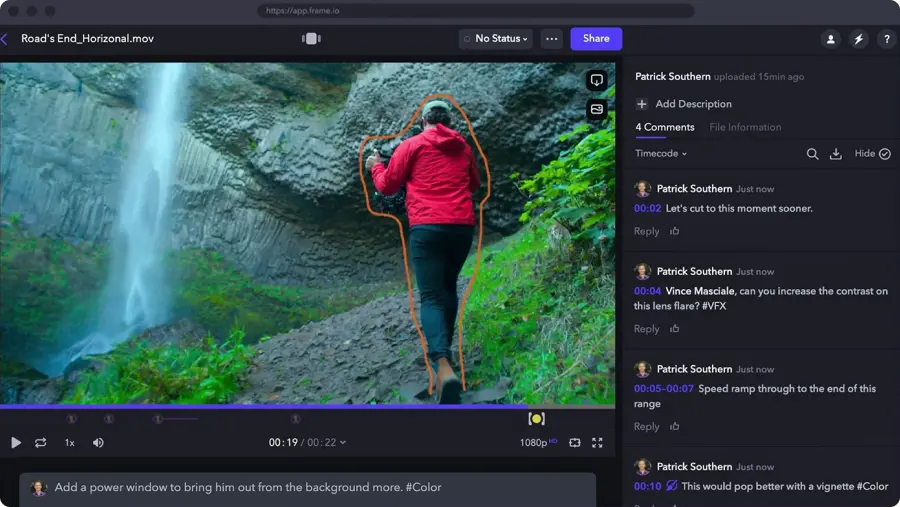
- Client Presentation: After internal revisions, the creative assets are presented to the client for their feedback. Using Frame.io, the client can leave comments and annotations directly on the creative files, which can be seen by everyone involved in real-time.
- Iteration and Refinement: Based on the feedback received, the creatives undergo revisions. Multiple rounds may occur, each time getting closer to a final product that aligns with the campaign’s objectives and target audience.
- Final Review: Once all feedback is incorporated and the creative assets are polished, they undergo a final internal review. This is the last checkpoint for quality and alignment with the creative brief.
- Client Approval: The final versions are then sent back to the client for approval via Frame.io. If approved, the assets move into the launch phase; if not, further revisions are made.
- Launch and Monitor: After client approval, the creative assets are launched as part of the live campaign. Monitoring begins immediately to ensure the creatives are performing as expected, and any necessary adjustments are made.
- Post-Campaign Review: After the campaign concludes, a post-mortem analysis is often conducted to review the effectiveness of the creatives in meeting the campaign objectives and KPIs.
- Storyboarding: This is particularly useful for video content. Storyboarding allows you to visualize the narrative of your Facebook ad or other social media campaigns, ensuring the message is coherent and engaging from start to finish.
Using a collaborative platform like Frame.io makes this process significantly more efficient by centralizing feedback and approvals, cutting down on email chains, and re ducing the likelihood of miscommunication. This ensures that the creative team, media buyers, and the client are all on the same page, every step of the way.
How Do Video Ads and Static Image Ads Work Together in Paid Social Media?
In the realm of social media advertising, both video and static image ads have distinct strengths and uses. However, the magic often happens when these two forms of creative are used synergistically within the same ad sets. This is particularly vital in an algorithmic competitive bidding system that governs the placement of ads on platforms like Facebook, Instagram, and others.
In addition, when you include both video and static image ads in the same ad set, you essentially give the algorithm more options to work with. The system can then dynamically serve the type of content that is most likely to engage a particular viewer based on their past behavior and preferences. For example, some users may be more inclined to stop scrolling and engage with a video, while others may find static images more appealing. Additionally, a video might be served more often when the user is on a Wi-Fi connection, whereas a static image ad may be more likely to appear in a lower bandwidth scenario.
By offering both options, you’re not only increasing the chances of resonating with a broader target audience but also optimizing the ad delivery for maximum impact and cost-efficiency. Algorithms have gotten exceptionally good at understanding user preferences and can dynamically allocate your budget to the ad format that is most likely to result in a conversion or other desired action.
In summary, using both video and static image ads within the same ad sets creates a more flexible and adaptable campaign. It leverages algorithmic intelligence to better match viewer preferences, ultimately improving your chances of achieving your campaign objectives.
How Do Influencers or Content Creators Play a Role in Creative Production?
Influencers and content creators have become invaluable assets in the realm of paid social media advertising. They provide a level of authenticity and relatability that’s hard to achieve with traditional ad creatives. User-Generated Content (UGC) created by influencers is increasingly used in social ads to promote products or services, leveraging the trust and rapport these individuals have built with their followers.
In the context of paid social media, influencers and content creators often collaborate with brands to generate UGC that aligns with the campaign’s messaging and goals. This UGC can then be repurposed into social ads, creating a seamless integration between organic and paid content. These influencer-endorsed ads often see higher engagement rates and better conversion metrics, as they bring a human element to the promotional content.
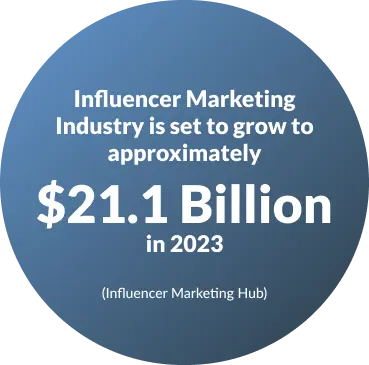
When using influencer-generated UGC in your paid social campaigns, it’s crucial to ensure that the content aligns with your brand values, messaging, and target audience. With the right fit, influencers can significantly amplify the reach and impact of your social ads, making them an essential component of a comprehensive creative strategy.
What is the Makeup of a Paid Social Agency’s Creative Team?
The composition of a creative team within a paid social agency can vary widely depending on the size and needs of the agency. However, there’s a general progression in roles as the team grows.
- Graphic Designer / Content Creator: The first creative hire is often a multi-talented individual capable of producing a range of static images and basic videos. This person is the jack-of-all-trades in the early days, responsible for all things visual.
- Copywriter: As campaigns become more complex, a dedicated copywriter might be brought on board to craft compelling ad copy, headlines, and other written content.
- Art Director: With a larger team, an Art Director becomes essential for mentoring and for overseeing the overall visual appearance of campaigns, ensuring brand consistency.
- Video Editor / Videographer: As video becomes more crucial, specialized roles for video production emerge.
- Creative Strategist: This role ties everything together, setting the creative direction based on research and data insights.
- Creative Director / Chief Creative Officer: As the team scales and the projects become more complex, a Creative Director or Chief Creative Officer takes the helm. This role oversees the entire creative vision, sets the strategic goals for the department, and ensures alignment with broader business objectives.
By the time a team has grown to 15-20 people, you’re looking at multiple individuals in some of these roles, perhaps even sub-teams focused on particular platforms or types of content. Specialized roles like Motion Graphics Designers, Creative Project Managers, and UI/UX Designers may also become part of the larger creative landscape. There may also be senior versions of these roles, like Senior Graphic Designer or Lead Copywriter, who take on more responsibility and mentorship duties.
What is the Best Way to Get a Graphic Design Job in Social Media Marketing?
Breaking into the social media marketing world as a graphic designer requires a strategic blend of skill-building, networking, and showcasing your creativity. Here are some key steps to follow:
1. Skill Development: First, make sure you’re proficient in industry-standard graphic design tools like Adobe Creative Suite, Canva, and others. You should be well-versed in designing for different platforms and formats, from Facebook ads to Instagram Stories.
2. Portfolio Building: Create a strong, diverse portfolio that displays your expertise in social media design. Make sure it includes actual client work or conceptual designs that could fit into real-world campaigns. Showcase your ability to develop visuals that attract the target audience and meet campaign objectives. Even running your own paid ad as a test to learn more would be a strong signal to a hiring manager.
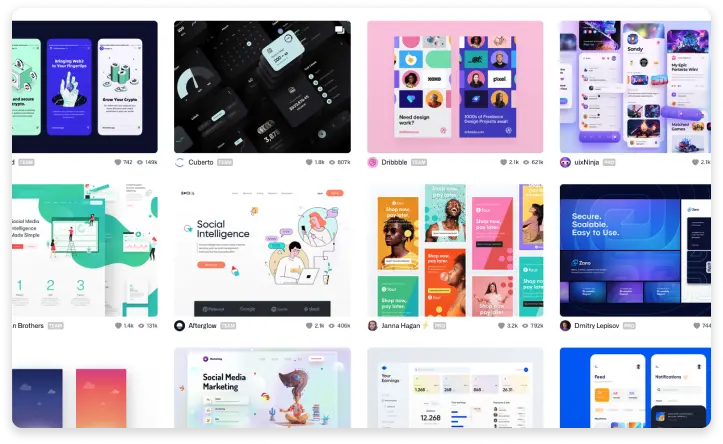
3. Specialize: Consider specializing in a specific area of social media advertising. For example, if you excel in video editing, highlight that skill. Specialization can make you more appealing to specific types of employers.
4. Networking and Community Engagement: Use social media platforms like LinkedIn to network with professionals in the field. Joining relevant groups, participating in webinars, and attending industry events can also boost your visibility. Don’t shy away from reaching out to mentors who could offer valuable insights.
5. Job Applications: Apply for entry-level positions or internships to gain real-world experience. These roles often serve as stepping stones to more advanced positions and give you an opportunity to work alongside seasoned professionals who can help refine your skills.
6. Continued Learning: The world of social media marketing is continually evolving. Stay updated with the latest trends, platform updates, and tools to remain competitive in the field.
By focusing on these areas, you increase your chances of landing a graphic design role in the rapidly growing world of social media marketing.
How Do We Do Creative Testing?
Creative testing is an essential component of a robust paid social advertising strategy. The goal is to find out which creative elements resonate the most effectively with your target audience, thereby driving the actions you desire, such as clicks and conversions. Here’s how to approach creative testing:
- Everything is a Test: Adopt the mindset that each creative you deploy is a test. Even your most meticulously designed ad is an experiment to gain insights into what resonates with your audience.
- Beat the Champion: This is often the default mode of operation. A “champion” ad or concept usually emerges on a monthly or quarterly basis. New creatives act as the “challengers” with the aim of outperforming the current champion, allowing for continuous improvement.
- Creative Concept Testing: Forget about focus groups; you can run these tests directly on your digital ad platforms. Here, the goal is to test different strategic value propositions like “price” versus “convenience” to see which appeals more to your audience.
- System-Run A/B or Multivariate Tests: Most social media platforms offer built-in A/B testing features, and you can also use more complex multivariate tests. These tools allow you to test different combinations of ad elements (headlines, images, CTAs, etc.) to gather richer data for analysis.
- Avoid Over-Optimizing for Local Maxima: It’s essential not to get stuck optimizing around small improvements. The more extreme the test, the clearer the results will likely be, and you’re more likely to find a breakthrough that dramatically improves performance.
All in all, creative testing is an essential component of a robust paid social advertising strategy. The goal is to find out which creative elements resonate the most effectively with your target audience, thereby driving the actions you desire, such as clicks and conversions. Here’s how to approach creative testing:
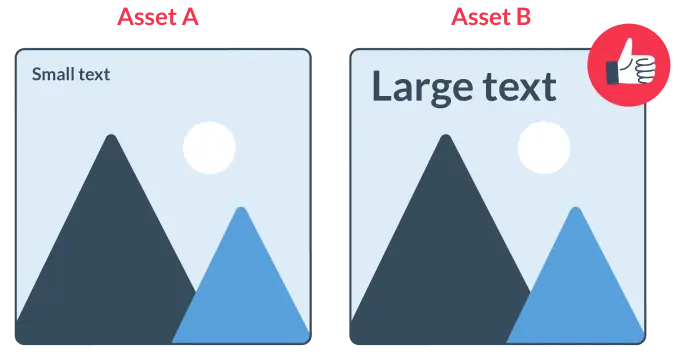
How Do We Measure Creative Performance?
Measuring creative performance in social advertising goes beyond just looking at clicks and impressions. It’s crucial to tie the effectiveness of your creatives directly to your business goals. Here are some key considerations for measuring the impact of your creative elements:
Return on Ad Spend (ROAS):
This is one of the most direct metrics that link creative performance to business outcomes. A high ROAS indicates that your creative is not only captivating but also effective at converting viewers into customers.
Click-Through Rate (CTR):
Although this is an upper-funnel metric, it’s a strong indicator of how compelling your creative is at capturing attention. A high CTR usually suggests that your ad resonates with the target audience.
Cost Per Acquisition (CPA):
This metric helps you understand how much it costs to acquire a customer through a particular creative. Lower CPA values generally signify that your creative is efficiently driving conversions.
Cost Per Click (CPC):
While CPC should be taken with a grain of salt, especially when optimizing for conversions, it does offer a competitive measure of how well your creative performs in the marketplace. It’s also a crucial part of understanding the financial funnel from click to conversion.
To sum up, by regularly monitoring these metrics and adjusting your creatives based on the data, you can iteratively improve the performance of your social advertising campaigns. Remember to use a dashboard to view these KPIs in real-time and make data-driven adjustments accordingly.
How Much Creative Should We Make?
Determining the right amount of creative content to produce for your social advertising campaign isn’t an exact science, but it is a crucial component of your strategy. Here are some guidelines to consider:
- Alignment with Business Goals: Start by identifying your campaign’s key performance indicators (KPIs) and business objectives. The scope and importance of the campaign can help you gauge how much creative output is necessary.
- Budget Constraints: Your financial resources will play a significant role in the quantity and quality of creative assets you can produce. If you have a limited budget, focus on creating high-impact creatives that directly align with your objectives.
- Platform Diversity: Different platforms may require different types and amounts of creative content. For example, a complex multi-platform campaign running on Facebook, Instagram, TikTok, and LinkedIn might need a more extensive creative library compared to a single-platform campaign.
- Testing Requirements: If you are following an approach that involves continual testing and optimization, you may need a more extensive array of creative assets to “beat the champion” or explore different value propositions.
- Audience Segmentation: If you have a diverse target audience with varying needs and preferences, you’ll likely require a larger pool of creatives to resonate with each segment.
- Campaign Duration: Longer campaigns often necessitate a larger volume of creatives to prevent audience fatigue and to keep the content fresh.
While the actual quantity will depend on a variety of factors, remember that quality should never be compromised. Use performance metrics to guide your decision-making and ensure that your creative efforts are yielding a positive ROI.
What Limitations Are There to Paid Social Creative?
Creating effective content for social ads is a nuanced process, and it comes with its own set of limitations. Here are some important factors to keep in mind:
- 🙅 Platform Restrictions: Each social media platform, be it Facebook, Instagram, TikTok, or LinkedIn, has specific guidelines and technical constraints around ad formats, dimensions, and lengths. This can limit your creative freedom and require adaptations for each channel.
- 💰 Budget Constraints: Budgets inevitably shape what you can and cannot do. High-quality video productions, for instance, are costlier and might be out of reach for smaller campaigns. It’s essential to create impactful creatives within your budget limitations.
- 👨👩👧👦 Audience Overlap: When running multi-platform campaigns, you may find that some of your audience exists on multiple platforms. This overlap can result in ad fatigue if the same creative is overexposed across channels.
- 💻 Algorithmic Limitations: Most platforms employ algorithms that optimize for particular metrics, potentially narrowing down the variety of content that gets displayed. This can sometimes hinder more explorative or innovative creative strategies.
- 🤳 Content Relevance: The ever-changing nature of social media trends can quickly make your creatives outdated or irrelevant, requiring frequent updates and revisions.
- 🚪 Data Privacy and Compliance: With increasing regulations like GDPR, CCPA, and platform-specific policies, your ability to target and customize creatives for individual preferences is becoming more restricted.
Moreover, understanding these limitations will help you devise more effective and adaptable creative strategies for your social advertising campaigns.
What is the Future of Paid Social Creative?
The future of paid social creative is an evolving blend of data-driven strategy, innovation, and adaptability. Here are some pivotal trends that are shaping the future landscape:

AI and Machine Learning: AI-assisted or AI-led production is already here, and we’re using it for select client campaigns. Creative production tools like Adobe already have embedded AI functionalities for ad creative, including for a video ad. The next frontier is the ad platforms themselves—Meta and Google are working on incorporating AI-driven ad creation directly into their ads manager, and then perhaps the tools themselves make the social media ad.
Personalization at Scale: Digital marketing changes quickly, and as data analytics become more advanced, we can expect a transition towards hyper-personalized creatives. Imagine ads so finely tuned they feel like they were designed just for you. Achievable through AI and big data, this level of personalization will be increasingly prevalent.
Dynamic Creatives: Platforms such as Facebook and Instagram already offer some dynamic creative options, but this will likely expand and become more sophisticated. Dynamic creatives will auto-adjust in real-time based on the viewer, enhancing the personalization experience further.
Immersive Experiences: Augmented reality (AR) and virtual reality (VR) technologies are on the rise, promising to make social ads more interactive and engaging. Virtual try-ons for fashion or 360-degree tours for real estate could soon be commonplace.
Sustainability and Authenticity: As consumers become more socially conscious, ads that are authentic and align with values like sustainability will likely garner higher engagement and trust.
Platform-Specific Innovations: Each social platform introduces unique formats requiring creative adaptation. Being flexible and quick to adapt to new formats will be crucial for success.
Cross-Platform Synergy: Given that people engage with multiple social media platforms, achieving a cohesive message and aesthetic across all of them will be increasingly important.
Regulations and Data Privacy: Stricter data privacy regulations will impact how much data can be used for personalization. The challenge will be to balance personalization with data privacy requirements.
Storytelling: As digital noise intensifies, storytelling will serve as a key differentiator, allowing brands to connect with audiences on a deeper, emotional level.
Consequently, staying ahead in this fast-evolving landscape will require agility, continuous learning, and a readiness to innovate and adapt.



